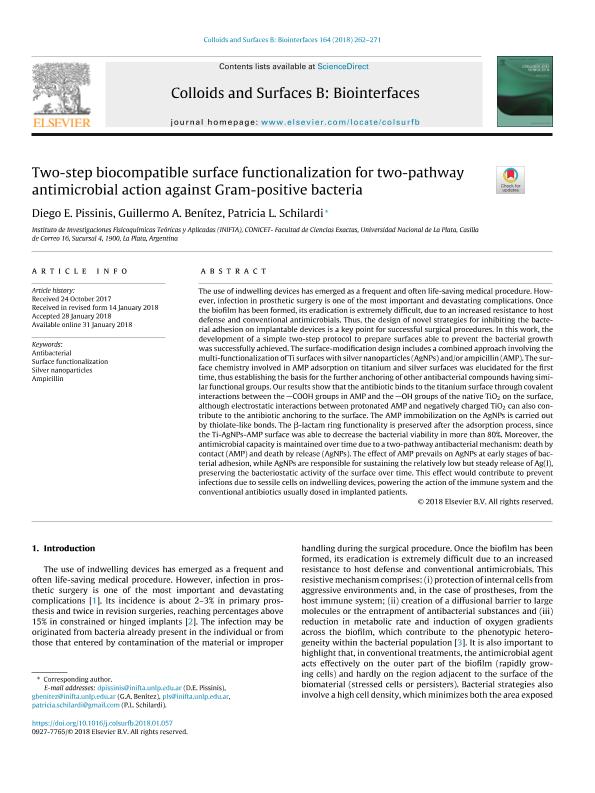Artículo
Two-step biocompatible surface functionalization for two-pathway antimicrobial action against Gram-positive bacteria
Fecha de publicación:
04/2018
Editorial:
Elsevier Science
Revista:
Colloids and Surfaces B: Biointerfaces
ISSN:
0927-7765
Idioma:
Inglés
Tipo de recurso:
Artículo publicado
Clasificación temática:
Resumen
The use of indwelling devices has emerged as a frequent and often life-saving medical procedure. However, infection in prosthetic surgery is one of the most important and devastating complications. Once the biofilm has been formed, its eradication is extremely difficult, due to an increased resistance to host defense and conventional antimicrobials. Thus, the design of novel strategies for inhibiting the bacterial adhesion on implantable devices is a key point for successful surgical procedures. In this work, the development of a simple two-step protocol to prepare surfaces able to prevent the bacterial growth was successfully achieved. The surface-modification design includes a combined approach involving the multi-functionalization of Ti surfaces with silver nanoparticles (AgNPs) and/or ampicillin (AMP). The surface chemistry involved in AMP adsorption on titanium and silver surfaces was elucidated for the first time, thus establishing the basis for the further anchoring of other antibacterial compounds having similar functional groups. Our results show that the antibiotic binds to the titanium surface through covalent interactions between the –COOH groups in AMP and the –OH groups of the native TiO2 on the surface, although electrostatic interactions between protonated AMP and negatively charged TiO2 can also contribute to the antibiotic anchoring to the surface. The AMP immobilization on the AgNPs is carried out by thiolate-like bonds. The β-lactam ring functionality is preserved after the adsorption process, since the Ti-AgNPs-AMP surface was able to decrease the bacterial viability in more than 80%. Moreover, the antimicrobial capacity is maintained over time due to a two-pathway antibacterial mechanism: death by contact (AMP) and death by release (AgNPs). The effect of AMP prevails on AgNPs at early stages of bacterial adhesion, while AgNPs are responsible for sustaining the relatively low but steady release of Ag(I), preserving the bacteriostatic activity of the surface over time. This effect would contribute to prevent infections due to sessile cells on indwelling devices, powering the action of the immune system and the conventional antibiotics usually dosed in implanted patients.
Palabras clave:
AMPICILLIN
,
ANTIBACTERIAL
,
SILVER NANOPARTICLES
,
SURFACE FUNCTIONALIZATION
Archivos asociados
Licencia
Identificadores
Colecciones
Articulos(INIFTA)
Articulos de INST.DE INV.FISICOQUIMICAS TEORICAS Y APLIC.
Articulos de INST.DE INV.FISICOQUIMICAS TEORICAS Y APLIC.
Citación
Pissinis, Diego Ezequiel; Benitez, Guillermo Alfredo; Schilardi, Patricia Laura; Two-step biocompatible surface functionalization for two-pathway antimicrobial action against Gram-positive bacteria; Elsevier Science; Colloids and Surfaces B: Biointerfaces; 164; 4-2018; 262-271
Compartir
Altmétricas




